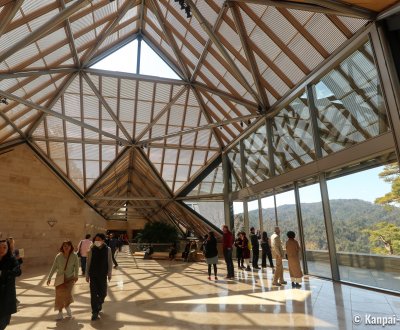Miho Museum
Arts in Otsu’s Countryside
Miho Museum is nestled in the mountains of Shigaraki in Koka City, in the south-east of Otsu and about one hour from Kyoto. This art gallery was designed by Sino-American architect I.M. Pei to host a very beautiful collection of artworks from throughout the world, in a very contemporary style.
Miho Museum was built in 1997 at the initiative of Mihoko Koyama (1910-2003), the co-founder in the 1970s of a new religious movement in Japan called Shinji Shumeikai or Shumei. Its headquarters and bell tower built in the vicinity are even visible from the museum. This messianic religion is based on three pillars: nature, beauty and light, all featured in the museum’s architecture.

A contemporary architecture in harmony with nature
The museum was designed by famous Chinese American architect I.M. Pei (1917-2019), who also created the Louvre Museum’s Pyramid and the eastern building of the National Gallery in Washington. The construction was 80% buried underground to better blend in the surrounding nature. From the sky, the museum indeed seems fusing with the forest and is almost invisible. The shape of the roof is inspired from Japanese architecture while the inside, more modern, is enlightened by natural light entering through large windows.
Thus, visitors can enjoy a panoramic view on the surrounding nature within which the museum is nestled. The site spreads on a total surface of 200 hectares (494 acres), divided into the two spaces of the Reception Pavilion and of the museum itself.

A Utopian Eden in a lost valley
The general layout of the museum was inspired by a tale famous throughout Asia, the Peach Blossom Spring (Tao yuan ji or Togenkyo 桃源郷 in Japanese) a fable by Tao Yuanming (365-427). A fisherman running up a river discovered a forest of blossoming peach trees. Out of curiosity, he explored the river to finally find its source, and a light attracted him into a cave. It was narrow at first, but eventually opened on wonderful landscapes of green hills and small rivers, where the happy inhabitants worked their fields in harmony with nature and protected from the outside world. This hidden paradise is an evocation of the legendary Shangri-La, a marvelous place where time is suspended in a peaceful and quiet atmosphere.
Contrary to the story in which the paradise remains inaccessible as no one could find the path again, the visitors, for a few hours, become the fisherman and follow his steps. At the exit of the Reception Pavilion, a wide alley lined with Japanese cherry trees 🌸 guides to a tunnel going under the mountain to the museum, that unfolds like an artwork.

The museum as an art paradise...
Mihoko Koyama was convinced that beauty and art are beneficial to the soul and thus gathered a collection of about 3,000 items and artworks, mainly from Asia, of which 250 to 500 are displayed to visitors, with the ancient Silk Road as a common theme. The simple museography, and the plays on lighting between semi-darkness and natural light immerse in a timeless atmosphere.
The exhibition spaces are dispatched into 3 levels, that can be freely visited:
- At the ground floor, you’ll find the main entrance, as well as a room dedicated to the Ancient Egypt;
- The south wing’s underground floor shelters the rest of the permanent collection and the largest exhibition space with artworks from Central and South Asia (Especially of India), China, Persian Empire, Ancient Greece and Rome;
- The north wing is dedicated to temporary exhibitions, often of contemporary artists. There is also a Japanese Zen garden.
The English-language audio-guide provides comprehensive explanations on most of the artworks and is available for rent.

...with all modern amenities
The museum also features a conference hall and an audiovisual documentation room, and it is naturally possible to eat at the museum’s tearoom (usually very busy).
At the Reception Pavilion, there is a small restaurant, as well as one of the three shops of the museum. An electric shuttle, with a dozen of seats, frequently runs between the museum and the Reception Pavilion.
Miho Museum will delight contemporary architecture amateurs, as its designer’s creativity was unleashed, associating technological progress with influences of traditional Japanese architecture to the ideals of its commissioner. The result is a timeless and dignified atmosphere, enhanced by the play of the natural light on a stone composition with warm hues and sharp angles contrasting with the ubiquitous lush nature.
Note that the museum may close without prior warning in case of a typhoon 🌀, and that is it closed several months in the year, especially in winter.

